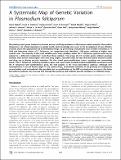| dc.contributor.author | Kidgell, Claire | |
| dc.contributor.author | Daily, Johanna | |
| dc.contributor.author | Borevitz, Justin O | |
| dc.contributor.author | Plouffe, David | |
| dc.contributor.author | Zhou, Yingyao | |
| dc.contributor.author | Le Roch, Karine G. | |
| dc.contributor.author | Ndir, Omar | |
| dc.contributor.author | Mboup, Soulyemane | |
| dc.contributor.author | Batalov, Serge | |
| dc.contributor.author | Winzeler, Elizabeth A | |
| dc.contributor.author | Volkman, Sarah K. | |
| dc.contributor.author | Johnson, Jeffrey R. | |
| dc.contributor.author | Sarr, Ousmane | |
| dc.contributor.author | Wirth, Dyann Fergus | |
| dc.date.accessioned | 2010-11-17T16:41:44Z | |
| dc.date.issued | 2006 | |
| dc.identifier.citation | Kidgell, Claire, Sarah K. Volkman, Johanna Daily, Justin O. Borevitz, David Plouffe, Yingyao Zhou, Jeffrey R. Johnson, et al. 2006. A systematic map of genetic variation in plasmodium falciparum. PLoS Pathogens 2(6): e57. | en_US |
| dc.identifier.issn | 1553-7366 | en_US |
| dc.identifier.uri | http://nrs.harvard.edu/urn-3:HUL.InstRepos:4569478 | |
| dc.description.abstract | Discovering novel genes involved in immune evasion and drug resistance in the human malaria parasite, Plasmodium falciparum, is of critical importance to global health. Such knowledge may assist in the development of new effective vaccines and in the appropriate use of antimalarial drugs. By performing a full-genome scan of allelic variability in 14 field and laboratory strains of P. falciparum, we comprehensively identified ≈500 genes evolving at higher than neutral rates. The majority of the most variable genes have paralogs within the P. falciparum genome and may be subject to a different evolutionary clock than those without. The group of 211 variable genes without paralogs contains most known immunogens and a few drug targets, consistent with the idea that the human immune system and drug use is driving parasite evolution. We also reveal gene-amplification events including one surrounding pfmdr1, the P. falciparum multidrug-resistance gene, and a previously uncharacterized amplification centered around the P. falciparum GTP cyclohydrolase gene, the first enzyme in the folate biosynthesis pathway. Although GTP cyclohydrolase is not the known target of any current drugs, downstream members of the pathway are targeted by several widely used antimalarials. We speculate that an amplification of the GTP cyclohydrolase enzyme in the folate biosynthesis pathway may increase flux through this pathway and facilitate parasite resistance to antifolate drugs. | en_US |
| dc.language.iso | en_US | en_US |
| dc.publisher | Public Library of Science | en_US |
| dc.relation.isversionof | doi:10.1371/journal.ppat.0020057 | en_US |
| dc.relation.hasversion | http://www.ncbi.nlm.nih.gov/pmc/articles/PMC1480597/pdf/ | en_US |
| dash.license | LAA | |
| dc.subject | infectious diseases | en_US |
| dc.subject | microbiology | en_US |
| dc.subject | systems biology | en_US |
| dc.subject | genetics | en_US |
| dc.subject | genomics | en_US |
| dc.subject | comparative genomics | en_US |
| dc.subject | parasitology | en_US |
| dc.subject | eukayotes | en_US |
| dc.subject | plasmodium | en_US |
| dc.title | A Systematic Map of Genetic Variation in Plasmodium falciparum | en_US |
| dc.type | Journal Article | en_US |
| dc.description.version | Version of Record | en_US |
| dc.relation.journal | PLoS Pathogens | en_US |
| dash.depositing.author | Wirth, Dyann Fergus | |
| dc.date.available | 2010-11-17T16:41:44Z | |
| dash.affiliation.other | SPH^Malaria/Wirth | en_US |
| dash.affiliation.other | SPH^Immunology and Infectious Diseases TPH | en_US |
| dc.identifier.doi | 10.1371/journal.ppat.0020057 | * |
| dash.authorsordered | false | |
| dash.contributor.affiliated | Sarr, Ousmane | |
| dash.contributor.affiliated | Wirth, Dyann | |


